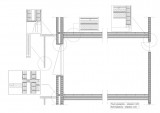Supervisor:
Architectural Technology
2004
Most buildings of the twentieth century are usually faced afterwards the determination of their form, with result thermal comfort in the interior is -literally- a product of air conditioning industry and other appliances, disengaging thus, in the level of planning, the possible contribution building’s skin in the internal spaces and the energy consumption of the building. Thus, the occasion to draw buildings that could correspond in the environment, because of their form and the smart use of materials with limited mechanical dependence, is limited.
For example, the use of cast concrete and bricks leads, generally, to airtight buildings, and the phenomenon is intensified through the utilization of plastic materials. This overloads the air’s quality, creating maladies in work space. In order to solve the problem we can use some technological solution, which maybe would not be necessary, if existed better initial planning. Parallel, the relation between the individual, the working place and the environment is re-examined and leads to an architecture that allows a dynamic interaction.
Similar problems are presented with the continuously increasing use of shades that move (annoying reflections) or special glass partitions (appearance of local thermal discomfort). It must be added also the problems in the control of daylight, the glare, the ventilation and generally the thermal discomfort, that are presented in the first double glass facades, which present in Greece. From the other side, the skin of other contemporary buildings begins to present more voids, aiming at the entry of daylight. This fact creates overheating problems, particularly during the summer, which is usually faced, with the use of air-conditioning units.
The present work is focused in the presentation of measures, for example climatic conditions of the region, orientation of the building, which need to be taken into consideration in the initial stage of planning, in order, afterwards, to shape designing and constructional proposals. These measures, initially, aim at the achievement of workers’ comfort in offices and then the saving of energy –and no reverse.
